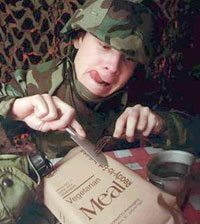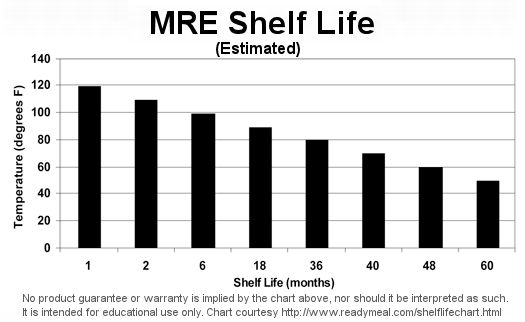
MREs have become the mainstay of the US Military field rations since they replaced the old C-Rations that came in a small cardboard box with the edible items in cans. The concept behind the MRE was to lessen the weight and space of field rations and provide enough calories for the soldier to maintain a level of combat readiness and activity. The MRE did attempt to accomplish that with space as now the meals are stored in a thick plastic bag and the items inside require little to no water to prepare. The shelf life increased a bit from the old rations but the weight, in some cases, has dramatically increased.
Calorie intake of ready-made MREs, the full meal and all the side dishes, deserts and beverage, averages out between 1000 and 1350, sometimes more. That is a tremendous amount of calories per meal when compared to what you would normally eat. This amount of calorie intake was generated with the projection that a soldier in combat will burn off those calories due to activity. That same school of thought is why some preppers stock MREs in their pantry. MREs also have a relatively long shelf life if stored in cooler temperatures.
Here is an example of what a basic MRE contains:
In side the main pouch:
One box measuring 8-1/4″ by 4-3/4″ by 3/4″ inches labeled “Chicken in Thai Style Sauce”. Inside the box is a flexible pouch containing an 8-ounce (227 gram) serving of chicken and sauce. This is the entrée.
One box measuring 7-1/2″ by 4-3/4″ by 3/4″ inches labeled “Yellow and Wild Rice Pilaf”. Inside the box is a flexible pouch containing a 5-ounce (142 gram) serving of rice.
• One flameless heater
• One 1.4 ounce (40 gram) foil package of crackers.
• One 1.3 ounce (37 gram) Nutra Fruit cereal bar.
• One packet of spiced cider drink mix
• One packet of instant coffee
• One packet sugar
• One packet salt
• One packet pepper
• One packet grape jelly
• One piece chewing gum
• One moist towelette
• One pack matches
• One packet toilet paper
• One plastic spoon
All together, this meal contains 210 calories for the chicken, 160 calories for the rice, 180 calories for the crackers, 130 calories for the cereal bar and 140 calories for the drink, jelly, etc., for a total of 820 calories for the meal.
Side note: official US military MREs are not for sale to civilians. Be aware of this in the event you come across someone trying to sell them to you at a gun show or surplus store. The outside of the case will actually have written on it ‘US Government Property, Commercial Resale is unlawful’. If you come across something like this in your many travels, be very cautious as you have no idea what these MREs have been exposed to. They could have been stored in an area subject to extreme temperatures and therefore their shelf life is non-existent.
See the chart below for MRE temperature and storage life.
While MREs are convenient as they contain the entire entrée, a desert, snack, drink mix, condiments and flatware all in one package, they still have issues. Primarily, military grade MREs and that encompasses those companies that sell MRE like meals for disasters, contain little to no fiber. That can lead to some serious and potentially painful issues as I’m sure you can imagine. Couple the lack of fiber with the high sodium content for preservation and that’s yet another potential problem that can affect your health. Weight is the final problem. Most cases of MREs contain only 12 meal packets but weigh 20 pounds or more making it inconvenient in relation to cost, space and weight considerations if you’re looking at being mobile like on foot and frugal as to how and what you spend your money on.
My overall thoughts on the use of MREs set aside for a survival situation, and I’ll stress this as only my opinion, is that MREs are great for convenience. They have an average of 5 years for a shelf life. They’re great for short term, like immediate use, but not something that you should plan on for long term. What that means is in the immediate aftermath of a catastrophic event, using MREs to feed yourself and your family while you’re on the move to a safer location like a pre-planned BOL, (see topic on BOL or Bug Out Locations) then by all means, use MREs. If MREs are your core stock of long term food storage, then I feel for you as you’re going to be experiencing some interesting side effects.
With all that we’ve just covered on pre-made MREs, can a person make their own?
The answer to that is absolutely. There is no need for a mass production or assembly lines as you’re only making meals for yourself and family. This allows for some creativity. The first item you’re going to want to invest in is a vacuum sealer. These can be found at almost any retail store from Wal-mart to Kohl’s and it’s up to you what you want to spend on it. However, you will want to locate a sealer that creates a solid seal and actually vacuums out the air before said sealing. One resource would be to locate the latest consumer reports at your library or book store and read the reviews. If you can’t locate the latest book then Google consumer reports then do a search for vacuum sealers. If that fails to return any results then just Google vacuum sealers and start reading reviews and taking notes. Be forewarned, the cost of a moderate quality sealer will be between $60-$100 and that should include several size bags. This cost is nominal when you consider the cost of buying a month’s supply of pre-made MREs by the case (up to $124.99 per case).
To make you own MREs is simple and the items can be found at any grocery store and/or dollar store.
The idea of each homemade MRE should be to include in each meal between 700 and 1,000 calories or more with a healthy dose of protein, carbohydrates, fat and fiber. While we could discuss literally thousands of combinations that could be included in each MRE, here is a good list of basic foods that can be drawn from to reach your goal:
Tuna, salmon, clams, turkey, ham and chicken in purchased vacuum packs
Dried fruit
Powdered soup mix
Instant oatmeal or Cream of wheat
Hard tack candy (that’s hard candy that you suck on)
Peanuts, almonds, sunflower seeds or pumpkin seeds, i.e. trail mix
Energy or survival bars
Individual packs of instant coffee, tea, fruit drink or energy drink
Instant rice, pasta, beans or lentils
Homemade trail mix (GORP if you know what that is)
Crackers (some of these can be found in larger packets with peanut butter or cheese depending on your preference)
Individual portions of peanut butter, jam or jelly
Individual packets of condiments
It’s important to make your MRE’s as diverse in the scope of their contents and use your imagination to create meals that will be appealing to the entire family. It is also wise to include in each MRE, plastic eating utensils and an individual packet of multi-vitamins in every other MRE. Make two different types of MRE’s – one set that requires boiled water and one that can be eaten as is. The reason for this is that you may not always be capable of boiling water such as when emergency travel is needed. Try to include items that have similar expiration dates in each MRE and when sealed, mark the expiration date clearly on the pack with indelible ink. Some bags already have a label that you can write on or you can just throw on some masking tape and write on that. Chances are that even with the purchase of the vacuum sealing system you’ll be able to make your own MRE’s for about 40% to 50% or less of the cost of pre-made MRE’s.
You may start wondering at this time where you can find condiments, those would be ketchup, mustard, hot sauce, and other like items in a single serve packet. Next time you visit McDonald’s, Burger King, Taco Bell or Kentucky Fried Chicken ask for extra packets of ketchup or if the packets are readily available, acquire a few and have whomever you’re there with do the same. A couple of trips doing this and you’ll have a small stockpile of single serve condiment packets that you can add to your home-made MREs.
If that doesn’t work for you, then the next time you visit Costco or a Sam’s Club wander down the aisle that has condiments and look for the case of the items you want to include and add that to your shopping list.
If you don’t have access or membership to either of these warehouse stores, maybe you have a friend who does and is willing to check the prices for these items the next time they go.
If all else fails, here are some links to ordering those items in bulk:
http://www.wildernessdining.com/condiments.html
http://www.minimus.biz/default.aspx?Affiliate=579
(I have not ordered from either of these sites so I do not know anything beyond what they advertise)
If you went the McDonald’s, Taco Bell, Burger King, KFC route, here’s a chart to keep handy from Heinz:
Heinz Corp. Products
(for single serving sizes)
-ketchup – 7-months
-chopped onions – 7-months
-mayonnaise – 8-months
-fat-free mayonnaise – 8-months
-relish – 9-months
-mild taco sauce – 9-months
-hot taco sauce – 4-months
-yellow mustard – 9-months
-BBQ sauce – 9-months
-steak sauce – 9-months
-tartar sauce – 8-months
-horseradish sauce – 8-months
-cocktail sauce – 9-months
-Tabasco sauce – 8-months
Taco Bell:
Sauce packets (fire, hot and mild) are best used within 120 days. (Don’t forget the sporks that can be found at Taco Bell.)
But keep in mind that is based on room temperature (70°F). For each 10°F hotter it’s stored in, cut the shelf-life in half. The ingredients in these packets are moderately good keepers because of high sugar or high acid content in them.
What I just covered is to be considered the very basics when it comes to creating your own MREs. Feel free to experiment, I’ve heard of people who created all vegetarian MREs and even Kosher MREs that means the possibilities are virtually endless.
Here are some examples of existing MRE menu choices by their numerical menu designation:
1. “Beefsteak w/Mushrooms and Western Beans”
2. “Pork Rib and Clam Chowder”
3. “Beef Ravioli and Potato Sticks”
4. “Country Captain Chicken and Buttered Noodles”
5. “Chicken Breast and Minestrone Stew”
6. “Chicken w/Thai Sauce and Yellow/Wild Rice Pilaf”
7. “Chicken w/Salsa and Mexican Rice”
8. “Beef Patty and Nacho Cheese Pretzels”
9. “Beef Stew”
10. “Chili and Macaroni”
11. “Pasta w/Vegetables in Tomato Sauce”
12. “Black Bean & Rice Burrito”
13. “Cheese Tortellini”
14. “Manicotti w/Vegetables”
15. “Beef Enchiladas”
16. “Chicken w/Noodles”
17. “Beef Teriyaki”
18. “Turkey Breast w/Gravy & Potatoes”
19. “Roast Beef”
20. “Spaghetti w/Meat Sauce”
21. “Chicken Tetrazzini”
22. “Jambalaya”
23. “Chicken w/Cavatelli”
24. “Meat Loaf w/Gravy”






